I spent more time thinking about what to pack for the South West Coast Path than I did actually walking it.
It’s pretty surprising when you consider I’ve tackled dozens of long-distance walks at this point in my life. But let’s just say this trail isn’t your average walk.
In fact, I’d say it’s the toughest hike I’ve ever done.
You see, the South West Coast Path involves walking 630 miles (1,000 km) across some of the most rugged parts of England. Over two months, you climb the equivalent height of Everest, not once, but four times. Throw in brutal weather, continual ascents and descents, days with barely another soul in sight, and the small detail that this was the first hike where I’d be camping along the way… yeah, I was pretty apprehensive.
For me, Weight Was the Most Important Aspect
I was diagnosed with flat feet at the tender age of two. On top of that, I overpronate and have hypermobile ankles. I also suffer from plantar fasciitis. And I get posterior tibial tendonitis when I run too far.
Needless to say, my feet are janky and walking is painful.
My biggest lesson from all these long-distance hikes I’ve completed? The more weight I carry on my back, the more pain I’m in.
I always say: an extra 100 grams in your backpack doesn’t sound like a lot, but when you’re taking 30,000 steps with that weight, your feet are lifting an extra 3,000 kilograms over the course of that day. And when your arches are as sensitive as mine? Every. Gram. Counts.
And therefore, every single item I packed had to fight for its life to be included. I didn’t want any unnecessary weight.
I therefore didn’t choose the cheapest items — or even the best-value ones. Instead, I was laser-focused on which products weighed the least, whether it was a toothbrush, sleeping bag, or can of deodorant.
I ran into a girl in a campsite on day four whose backpack weighed 14 kilograms; she was already taking taxis from one spot to the next because her knees were killing her.
My backpack ended up weighing 5.5 kilograms without water, which is pretty damn light for a two-month-long walk.
What This Packing List Includes
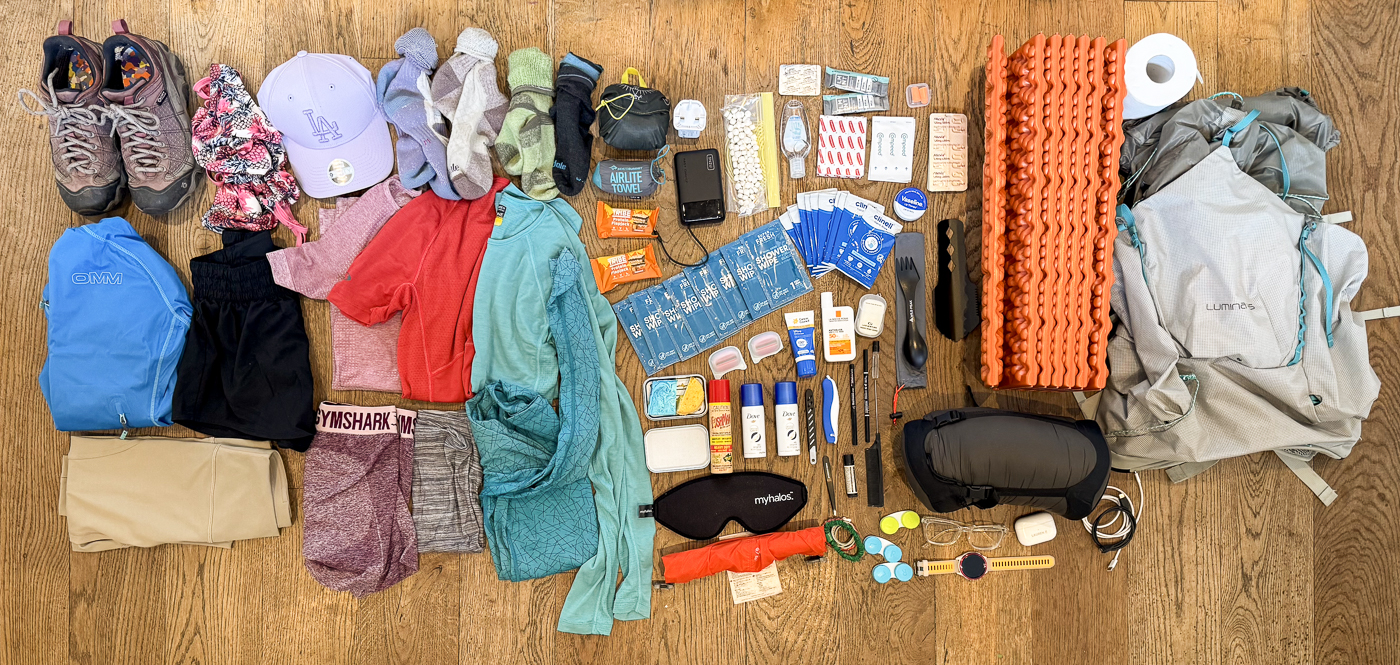
Obviously, this packing list is going to include everything I personally carried on the South West Coast Path. I’ve split the guide into categories: clothing, camping, toiletries, medication, technology, and then all the other remaining miscellaneous stuff.
For every item, I break down why I chose that specific version, whether I loved or loathed it, and how much it weighed. I give alternatives if I didn’t like what I chose, share which items I posted back home or threw away, and mention additional products you might want to bring that I couldn’t justify packing.
In other words, I’m writing the article I wish existed when I first decided to walk this path.
Without any further waffling, then, let’s get into it.
The Essentials

Let’s start with the basics. The essentials. These are all the things you wouldn’t be able to tackle the trail without. In my opinion, this is also the area where it’s really worth spending some money.
Having the right backpack, tent, and sleeping set-up really can be the difference between a miserable night shivering on the ground and waking up refreshed and ready for the next 20-mile section. Here’s what I chose to bring with me:
A tent: This was an easy decision. Dave and I already owned the NatureHike Cloud-Up 3 and have used it on multiple camping trips in Australia. It’s a three-person tent, is inexplicably inexpensive, and seems to have a cult-like effect on anyone who sees it in action: I’ve lost count of how many friends have seen us pitch our tent, then gone home and ordered one.
It’s particularly easy to set up and take down — I can do it solo in under five minutes — weighs just 2.2 kilograms, and performs well in wind and rain. I have no complaints and it held up against the wild weather of the English coastline.
A sleeping bag: I always splurge on my sleeping bags because for me, they’re the difference between a solid night’s sleep and hours spent shivering or sweating. And when you’re hiking 600 miles in one go, bad sleep is going to make everything feel that much harder.
I’m short, too. At 5’2″, I winced at every generic, one-size-fits-all sleeping bag I tried, because I could see I’d be carrying about eight inches of extra material I wouldn’t even use. That’s why I love Sea to Summit’s lightweight sleeping bags: not only are they comfortable, cosy and durable (the one I bought for the Camino is still perfect, six years later!), but they also make versions for women and shorter people! Their women-specific line is narrower at the shoulders, wider at the hips, and has extra insulation in the footbox.
I decided to buy their Spark sleeping bag for this walk, which is rated down to -1°C and weighs just 584 grams. It might sound like overkill, but it was perfect for those overnight lows and I think I’d have been cold in anything lighter. Even when it was 26°C overnight, I found it comfortable to sleep in. On chillier days, I was so cosy and looked forward to sliding into it every night.
A foam mat: When I tell you that this was a dilemma that consumed an entire week of my life. Do you go air mattress or foam?
Air mattresses win on warmth and comfort but lose on weight, noisiness, faff (ten minutes of huffing and puffing every night), and the ever-present risk of waking up on a flat balloon. In contrast, foam mats are lighter, tougher, and set up in seconds, but with far less padding and insulation.
I personally hate an air mattress. As a restless sleeper, I find them loud, wobbly, and nausea-inducing. Foam, it turns out, was really my only option. I went with the Nemo Switchback, a foam sleeping pad that’s beloved by ultralight hikers. At 400 grams, it’s lighter than an air mattress, concertinas up into a wedge in half a second, and insulates surprisingly well.
Was it comfortable to sleep on? Nope!
Well, not at first. For the first week, it felt like sleeping on the ground, but I quickly adapted and grew to enjoy resting on a firm surface. But really, it was the sheer convenience that made me a convert. Each afternoon, my sleeping set-up was ready in 10 seconds flat, while Dave was puffing into his mat for a solid five minutes. I’d 100% make the same choice again.
Note: I didn’t bring a pillow with me. Instead, I stuffed my clothes inside the sack for my sleeping bag and used that. Surprisingly, it was more comfortable than using a pillow. (Dave brought an inflatable pillow, which sprang a leak on the first day!)
My backpack: Here’s where I’m going to be deeply unhelpful. I walk with an Osprey Lumina 45L… which you can’t buy anymore. At 700 grams, it was the lightest backpack on the market, and I loved it so much I panic-bought five spares when Osprey discontinued it. I wanted to ensure I would have access to this backpack for the rest of my life.
If that has you intrigued, you can usually buy the Lumina (or the Levity, the male version) on eBay. Otherwise, Osprey is still my go-to brand. I’ve been travelling exclusively with their packs since 2011.
If you stole my stash of Luminas, I’d probably go for the Osprey Eja Pro 45 (870g) as my second-choice. A lot of serious thru-hikers like the ULA Circuit at the moment (873g), too; it’s the most popular backpack on the PCT this season, so I’d consider that one as well.
Still, odds are, you already have a backpack you like, so stick with that. There’s no need to throw money at something new unless you’re desperate for an upgrade.
Clothing
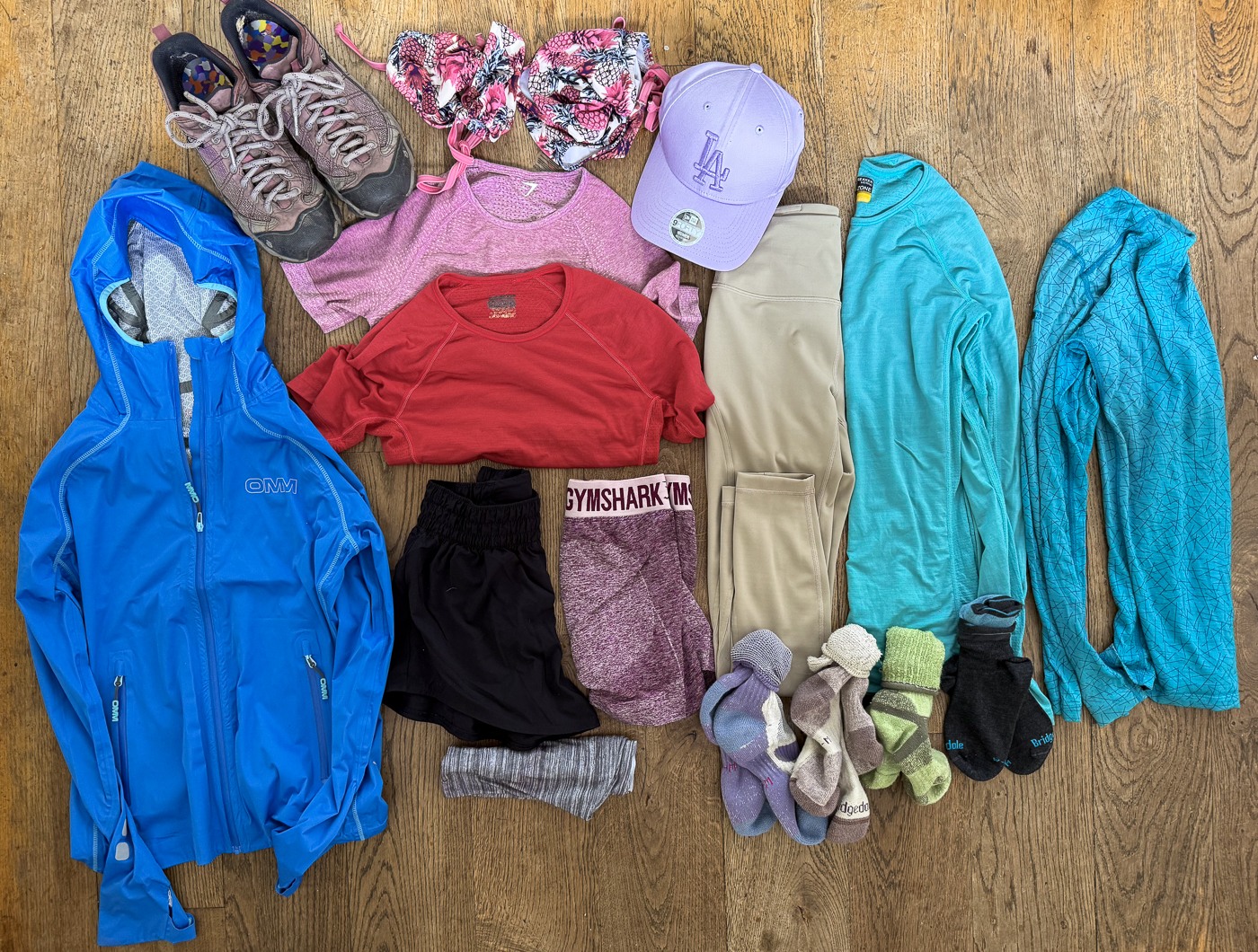
The more long walks I tackle, the fewer items of clothing I bring with me. These days, I pack light. Experience has taught me that less is more — as long as you have an outfit for every conceivable situation.
Still, I won’t deny that the English weather has a way of keeping you on your toes.
Heatwaves, gales, and thunderstorms can all hit in a single day on the South West Coast Path. Think about what you might encounter on the trail: what will you wear on a 35°C day? What if it’s 10°C and pouring with rain? What if there’s a section of forest that’s blanketed in ticks?
My clothing list is pretty small, but each piece was carefully chosen to deal with whatever the trail might throw at me. Whether it was boiling hot, freezing cold, or soaking wet, I was generally comfortable throughout the walk.
Fabric matters, too. I leaned heavily on merino wool for tops and base layers because it doesn’t smell after days of wear, is warm when cold, cool when hot, and quick to dry.
Here’s what I took with me:
Two T-shirts: I found that two t-shirts was the perfect amount; I really didn’t feel like I needed more than that. Both of the tops I brought were very quick-drying (half an hour in the sun), so it never felt like much of a chore to wash and dry them in the afternoon. I opted for a merino wool 150-weight Icebreaker t-shirt and a Gymshark Vital t-shirt; I’ve worn both of these on dozens of hikes, so know they’re durable and don’t smell of sweat after a day of use.
Two long-sleeved tops: I decided to bring two long-sleeved tops with me — one 150-weight to work as a thin base layer and one 250-weight, thicker option to keep me warm at night. Both were from Icebreaker, because merino wool really is king on a walk like this. On really cold days, layering a t-shirt, the two long-sleeved tops, and a rain jacket worked surprisingly well to keep me warm. I considered bringing a fleece with me, but it would have added a lot of extra weight.
Two pairs of shorts: I spent most of the hike in shorts, so carrying two pairs made it easier to wash and dry each in rotation. I went with a pair of Gymshark shorts that I’ve walked in before and know are comfortable and durable, plus a lightweight, baggier pair of Nike shorts that I walked the Norfolk Coast Path with. Both were breathable in hot weather, weighed around 30 grams, and dried quickly after getting wet.
One pair of leggings: An absolute essential, even in summer. Ticks were everywhere during the first week of the walk, when the foliage was particularly overgrown, so leggings were crucial for protection. In the evenings, the sea breeze often dropped temperatures down to around 13°C. Without leggings, I would have been freezing! I walked in shorts for much of the hike, but when I needed leggings, I was so glad to have them. I wore the Lululemon Wunder Train leggings, and found them to be warm yet breathable; exactly what you want on a hike like this.
One rain jacket: England is famous for its rain, and while the South West Coast Path wasn’t particularly damp for me, you’d be a lunatic not to bring a waterproof with you!
I have alarming levels of affection for my rain jacket: the OMM Kamleika. This jacket is amazing. I really don’t like the bulkiness, noisiness, and boxiness of a typical raincoat, so having something flattering that weighs 220 grams and is soft and smooth and silent… I love it so much.
The waterproofing is great, too — it stood up to all rainstorms encountered on the walk, and I even tested it by wearing it in the shower before starting out. I remained dry! If you haven’t found a waterproof jacket you love, I recommend this one a lot.
One bikini (97g): Because how could you walk the South West Coast Path without taking at least one bracing ocean swim? Whenever we arrived at a beach town before 3 p.m., Dave and I would spend an hour or two decompressing from the hike on the sand. By September, it was too cold for me to consider a swim and I shipped it home.
One buff: Prepare yourself, because you’re going to hear a lot about how uncontrollable my hair is in this packing list. Even when I tie my hair back, I end up with lots of frizz and flyaways, and I’ve found that a buff-used-as-a-hairband is the best way to keep everything out of my face.
One baseball cap: This was a last-minute purchase — like, the night before! — but I’m so glad I made it. I don’t usually hike with a cap because I don’t like having a sweaty head, but conceded I would be walking into the sun for hours a day with little shade. Plus, twelve hours outside every day? I didn’t need that skin aging!
And yes, I acknowledge the Europeancore of buying a baseball cap for a random American team I couldn’t tell you the first thing about (I also just double-checked the Dodgers are a baseball team) — it was the only option Amazon could deliver in 12 hours!
One pair of hiking shoes: Everyone has their own preferences when it comes to footwear. I’ve tackled tons of long-distance walks, so I’m well attuned to what works for me and what doesn’t.
No hiking boots and no trainers. Instead, I opt for supportive, low-rise hiking shoes with custom orthotics for my flat feet. I’ve been wearing Oboz Sawtooth hiking shoes for years (I bought my first pair in 2012!) and they’ve served me well over that time; I bring them on most of my long walks.
One pair of liner socks: A great way to prevent blisters is to wear liner socks beneath your hiking socks. In theory, the liner sock sticks to your skin while the hiking sock sticks to the shoe. When you walk, the friction that normally would cause blisters now happens between the two layers of fabric rather than directly on your feet. I’ve been using liner socks from Bridgedale for years.
Two pairs of hiking socks: There’s three pairs of socks in my photo, but I changed my mind at the last minute and took two instead. I was absolutely fine with two — I just washed the pair I had been wearing every afternoon and they were dry by morning. If they weren’t, no worries: the liner socks are what ended up smelling, so I could wear the outer hiking socks for a solid week before they needed a wash. I also went to Bridgedale for these; I love their mid-weight hiking socks.
Toiletries
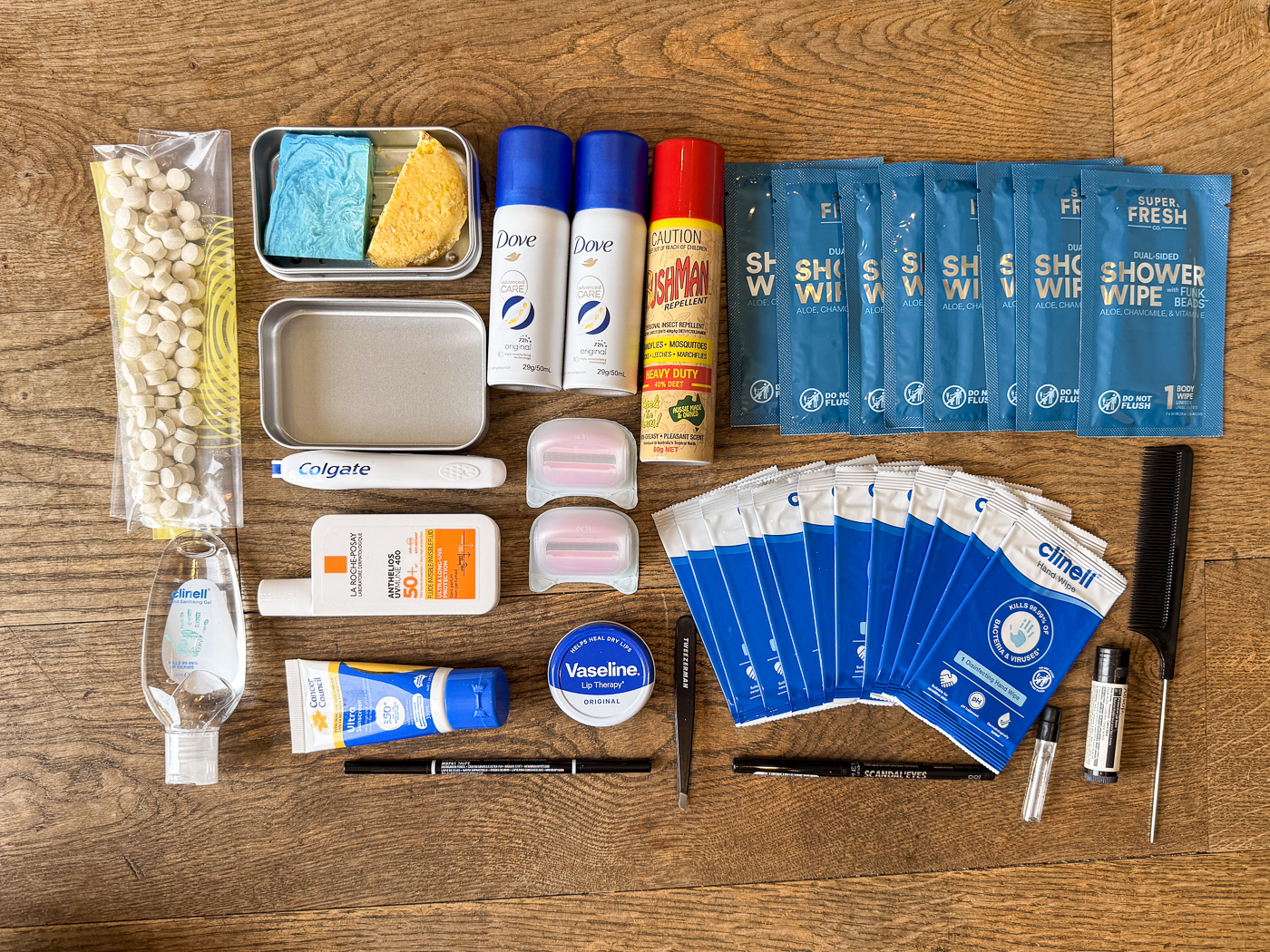
My toiletry choices were guided by the fact that I’d be camping — and sometimes wild camping — without access to the conveniences of a guesthouse or hotel. In particular, shower wipes, hand wipes, and hand sanitiser were essential for days when I didn’t have access to running water.
As with every other item on this packing list, my decisions here were based around minimalism and weight: for each and every product, I spent significant time hunting down the lightest versions of them.
Toothbrush and toothpaste: I used a Colgate portable soft toothbrush (20 grams) that folds into itself to keep the bristles clean, paired with solid toothpaste tablets from Parla. Note: this was my biggest packing mistake by far, and I’d recommend bringing a travel-sized tube of toothpaste instead. Unsurprisingly, the tablets ended up getting crushed in my backpack (they shipped in a glass jar, I couldn’t justify the weight, put them in a bag, disaster ensued) and I was dispensing powder into my mouth within a couple of weeks.
Shower products: I bought a Lush Godiva shampoo-and-conditioner bar, as I usually do, as it’s the only 2-in-1 they make. I also chose the Outback Mate soap, which is mint- and eucalyptus-scented. As you can see from the photo, I cut both products in half to save on weight; in reality, I cut them too small and struggled to make them last until the end.
A metal tin (35g): I picked up an aluminium soap tin to store my shampoo/conditioner and soap in. It was super-lightweight and had a drainage layer, so didn’t get gross and goopy after a shower.
Travel-sized deodorant: I managed to pick up a couple of 29 gram bottles of Dove deodorant at a chemist, so brought those with me. Two lasted me the entire hike. Why not just bring one? I knew I wouldn’t have reliable access to a large enough chemist that sold travel-sized products; I didn’t want to run out and end up having to buy a normal-sized can (200 grams!) for the rest of the walk.
Two razor heads (4g each): I bought a pack of Gilette razor heads and packed two for the trail. I felt like bringing an accompanying handle would just add extra weight and wasn’t necessary.
Insect repellent: The first few days of the South West Coast Path are rife with ticks, and walkers have caught Lyme Disease while passing through. That’s a souvenir I definitely didn’t want to come home with! And I can vouch for the stories: on the walk between Porlock and Lynton, I found eight ticks on my backpack and clothes. Fortunately, no bites! I bought some heavy-duty insect repellent and sprayed it liberally every morning. Once I entered Cornwall, I didn’t encounter ticks again, so threw it away to save on weight. I’d name it an essential for the first couple of weeks, then it can be tossed.
Sunscreen for face and body: I couldn’t believe how tanned I got on this walk, but when have I ever spent 12 hours in the sun, day after day after day? Some days, the temperatures were as high as 33°C, and most days, you’re walking on an exposed cliff, so have no shade. Sunscreen was an absolute necessity. I bought a 50 ml SPF50 La Roche-Posay sunscreen for my face, and a 50 ml SPF50 sports sunscreen for my body. Once the temperatures dropped, I didn’t bother with sunscreen on my limbs, as the sun really wasn’t that strong.
Shower wipes (15g each): This is an item you’ll only want to bring if you think you might be wild camping along the route. Obviously in that situation you won’t have access to showers, so that’s when shower wipes come in! I picked up a handful of body wipes from FunkBlock (5 grams each) and they were great! One side is soft; the other exfoliates, and they were large enough to use on my entire body. I felt really fresh and clean afterwards!
Clinell hand wipes: Wet wipes are always useful on a long hike, and especially one where you’ll be camping. Cleaning your hands before eating, wiping away dust and grime, or needing to go when the nearest toilet is a 10-mile walk away: the uses are endless. Just remember to bring a small sandwich bag with you to pack them out afterwards, as they aren’t biodegradable. I bought mine in individual sachets from Clinell, so they wouldn’t dry out after the first use.
Hand sanitiser: I also brought a small 50 ml bottle of Clinell hand sanitiser with me, mostly for cleaning my hands or utensils.
Lip balm: Spending twelve hours a day outside in the sun is a surefire recipe for cracked and dry lips. I found this lip balm with SPF to be an absolute essential on the trail, even though I’m somebody who typically doesn’t wear lip balm in everyday life. Whenever I forgot to use it, my lips would get so sore.
Vaseline: One of the best ways to prevent blisters on a long-distance hike is to apply Vaseline between your toes each morning. Blisters, after all, are formed by friction, and if your toes can glide past each other and your shoes, they’ll be kept at bay. I used this for the first couple of weeks until I felt like my feet were trail-hardened and unlikely to form blisters again. A small tin weighs 20 grams.
A comb: I have been blessed with wild, voluminous, curly, frizzy, dense, unmanageable hair, and not in a good way. I have a mane. Without some way to brush my hair, I cannot imagine how tangled it would be by the end of the walk. This La Moda pintail comb wasn’t the best solution, as I broke a lot of hairs dragging it through after a shower, but was the lightest (6 grams). And it meant that I didn’t return home with dreadlocks.
Tweezers (13g): Just like the hair on my head, my eyebrows can get more than a little unruly if I leave them be. I carried some lightweight Tweezerman tweezers — the best brand I’ve used — to keep myself groomed on-trail.
Eyebrow pencil and eyeliner: Neither of these were essentials, but it was nice to feel a little more put together when hitting up a fancy restaurant in Port Isaac or St Ives — or when celebrating Dave’s birthday at the mid-way point. Each item weighs just 5 grams, so it was a little luxury I felt I could justify. I bought the Rimmel Scandaleyes Eye Definer and the Nyx microbrow pencil; both were inexpensive.
A tiny tube of perfume: For much the same reasons, I carried a small sample bottle of Jo Malone perfume on the walk, too. Weighing just three grams, it meant that I could feel more human every now and then on the trail.
Medication
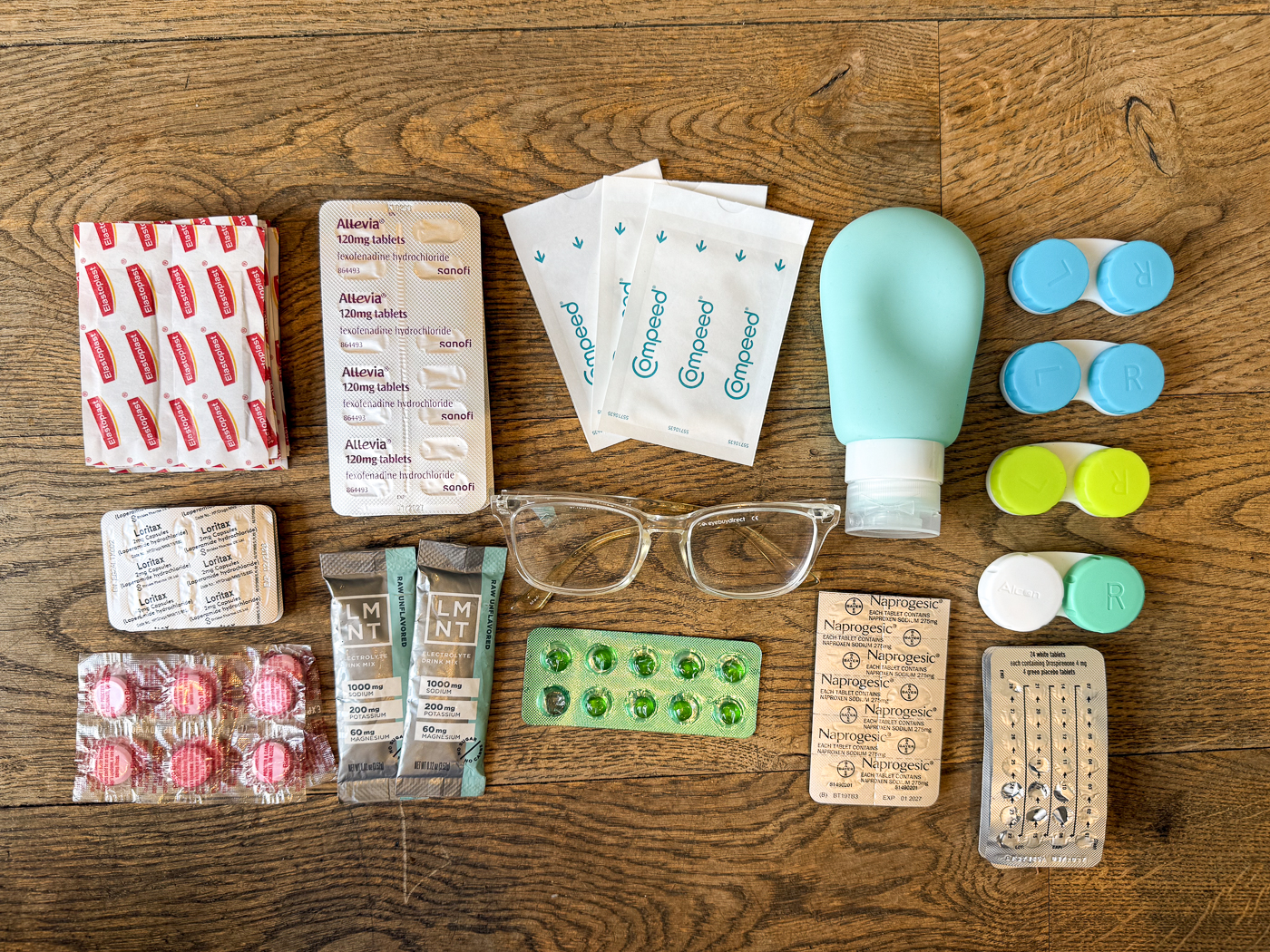
You’ll have reasonable access to pharmacies while walking the trail, but I’ll confess there were definitely fewer than I expected when starting out.
Most towns and cities have chemists, but you might only pass through one every three days. If you find yourself needing medication urgently, you would have to leave the trail (which isn’t always easy) and call a taxi to reach the nearest town.
Supermarkets and grocery stores carry basic medications, like painkillers and antihistamines, but anything more specialised is harder to come by. Case in point: when Dave’s toenail turned black, we couldn’t access any treatment for two days. Hobbling and grimacing ensued.
All that said, I think it’s wise to travel with any medication you might need urgent access to; imagine getting food poisoning and not being able to treat it for days.
With that in mind, here’s what I brought with me:
Compeed: Every hiker should travel with a couple of Compeed plasters. They cushion and protect blisters and contain a gel that draws out moisture to help them heal faster. I recommend buying a pack of mixed-sizes because the larger ones won’t easily wrap around smaller areas.
Plasters: I have strong opinions on plasters, having limped my way along more than my fair share of long-distance walks. I only hike with Elastoplast Finger Strip plasters; these bandaids are so sticky that you could wear them for weeks. They’re particularly great for any blisters on your toes, so I bring these in addition to Compeed.
Antihistamines: Spending 24 hours a day in the countryside will make anyone’s eyes itch; even me, who doesn’t usually suffer from hayfever. Camping added a whole other layer of exposure to my system, though, and I found myself needing an antihistamine every day. I always opt for fexofenadine because it has the lowest anticholinergic burden and won’t make you drowsy, which is important on a long hike.
Anti-inflammatories: When you’re walking 30,000+ steps a day in summer heat, your feet are inevitably going to end up swollen and sore. Painkillers have sometimes been the difference between me finishing for the day or collapsing to the ground and refusing to take another step. Anti-inflammatories work better for hiking-related mishaps than paracetamol, as most pains will be related to inflammation.
Imodium: My worst nightmare was dealing with an upset stomach while miles away from a toilet. I carried Imodium as a backup plan, and whenever wild camping was a possibility, took one pre-emptively to avoid digging a hole in the ground.
Electrolytes: Hot weather and long walks can leave you dehydrated, especially on those 30+°C days. I carried a couple of LMNT electrolyte sachets for any emergencies like these.
Pepto Bismol and Pudin Hara: It’s almost impossible to follow a healthy diet on the South West Coast Path, thanks to the plethora of pasties, cream teas, and fish and chips. Even if you did eat healthily, the sheer number of calories you burn each day means you’d be exhausted from walking in a calorie deficit (I burnt 4,000 calories on my longest day!). Pepto Bismol and Pudin Hara helped whenever I felt nauseated from food. Not essential, but comforting in moments of despair.
Birth control pills: There is no medical reason why women can’t take birth control pills every single day to avoid getting a period. I haven’t had one for years. And I can’t imagine having to deal with that while camping. This was an essential for me: enough pills to last the entire hike.
Contact lenses and solution: I don’t like wearing glasses while hiking — they slide down my nose whenever I’m looking down on descents! — so bringing contact lenses were a non-negotiable. I brought four pairs of monthly contacts with me (I lose them a lot) and a small bottle of solution for cleaning them.
Glasses: For emergencies, like losing all eight of my contact lenses, or simply wanting a break from wearing them.
Technology

For the most part, the only technology you’ll need for the walk is a smartphone, charger, and cable. If you’ll be camping, you’ll want a power bank of some kind, because you might only have access to power every two or three campsites.
Here’s what I brought with me:
iPhone 16 Pro (200g): As much as I’d have loved to have spent the entire walk offline with all my devices at home, I needed access to my iPhone on a daily basis. Walking the South West Coast Path was a business activity — as I’ll be writing about it on this site — so having my phone to take photos along the way was essential.
I also used my phone for navigating, finding restaurants and cafes, locating campsites the night before, phoning to check they had availability, checking we were still on the path using AllTrails, letting my parents know I was okay, calling taxis, researching bus routes and timetables, and making notes on each day’s walking in the evenings. The torch on my phone also doubled as a flashlight at night, which meant one less item to carry.
Power bank (380g): Finding the perfect power bank was tough. These things are heavy — like half a kilogram heavy — and I didn’t want the extra weight in my pack. That said, it was really important to have this. As I mentioned above, we sometimes went three days without access to power (roughly half the campsites had power sockets you could use). My phone lasts about 24 hours in flight mode while taking a few hundred photos, so running out of charge was a real possibility.
For ultralightweight power banks, thru-hikers typically use either Nitecore or INIU. Based on Reddit anecdotes, I got the impression that Nitecore banks are more likely to fail to mid-hike; so INIU was who I went with.
I opted for their 20,000 mAh power bank, which weighs 380 grams, has a 45W output and could fully charge my iPhone 3.5 times over. Dave went with the 10,000 mAh option (230 grams), and while he’d tell you he was happy with it, he had to expend a lot more energy on finding power sources, and ran out of charge several times. For me, the extra weight was worth the reassurance I’d stay powered throughout the walk.
Airpod Pros: These aren’t an essential for the South West Coast Path, but I’m somebody who can fall asleep within three minutes if, and only if, I have a podcast playing in my ears. For me, they were a no-brainer. On windy nights, the active noise cancelling blocked the rustling of the tent; in child-friendly holiday parks, they drowned out tantrums.
Garmin Forerunner 570 (50g): I wanted to travel with a fitness tracker because the data they provide is always so interesting. I already owned a Garmin Forerunner 570, so there was no question over whether I’d be taking it with me. I loved digging into all of the facts and figures from my walk: the number of steps, the level of stress I was under, how many metres I’d ascended, the calories I’d burnt, the amount of water lost through sweat… My Garmin even generated a map and elevation chart at the end of each day; perfect for showing friends how brutal the day’s activities had been!
Charger (92g): It’s surprisingly difficult to find a lightweight charger that has two USB-C ports and charges devices quickly — mostly because those U.K. plugs are so big and bulky! At most campsites, we had access to power sockets in the laundry room, so could only charge phones and power banks for an hour or two each evening; speedy charging was essential.
Both Dave and I settled on the Anker 523 47W charger, which weighs 92 grams. It sounds like a lot for a charger, but we genuinely couldn’t find a decent alternative that weighed less!
Charging cables: I brought one cable for my Garmin and one for my iPhone/Airpods (I left the second Apple one in the photo behind).
Miscellaneous Items
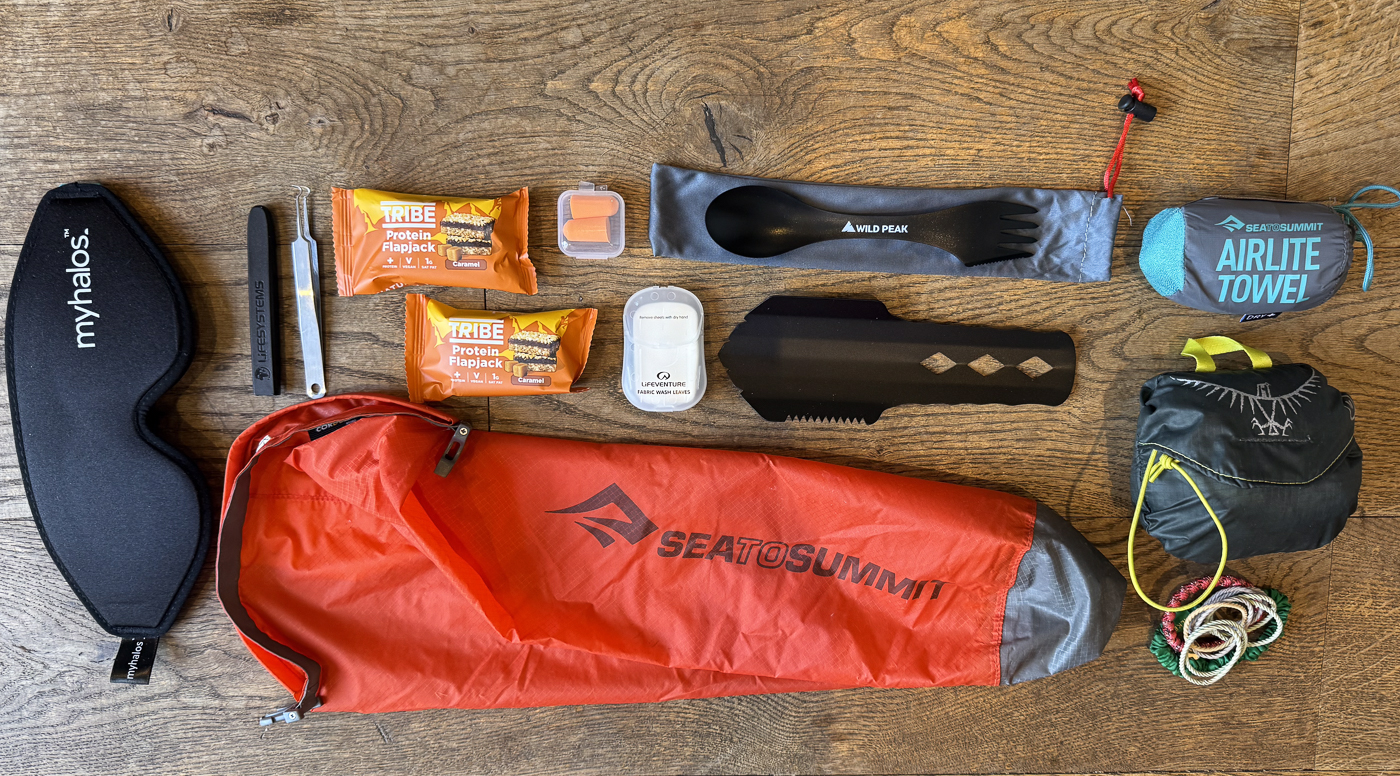
Finally, we have everything that didn’t conveniently fit into the other categories of my packing list. Think: items like laundry sheets, tick tweezers, a trowel, and a waterproof bag cover. I couldn’t imagine leaving any of these behind. Here’s the what and the why.
A spork (10g): I didn’t end up using this a whole lot, but it came in handy when eating in the wild or snacking on fish and chips. This Wild Peak spork is actually a spknork (yes, I made that term up), as it’s a spoon, knife, and fork in one. It’s also the lightest one I could find, weighing just 10 grams; easy to justify taking.
Laundry sheets (14g): I love these laundry sheets from LifeVenture and couldn’t imagine travelling without them again! A pack of 60 detergent sheets weighs just 14 grams, and I used two or three per wash. Fill a sink with water, dissolve a couple of sheets in it, and wash your clothes. I found they worked well, removing stains, sweat, and smells, making life on the trail more pleasant.
Tick tweezers (18g): I mentioned above that ticks are rife during the first few days on the South West Coast Path, and there’s plenty of walkers who’ve ended up with Lyme Disease because of it. As somebody who didn’t grow up in an area with ticks — and who had never even seen a tick before — I felt like I needed a tool to help me out. The LifeSystems tick tweezers had the best reviews of any I could find online, and weighed just 18 grams. While neither Dave nor I got bitten on the hike, we did find ticks on our bodies, so this is one product where it’s better to bring than not.
Travel towel (30g): I could not believe how lightweight this Sea to Summit Airlite Towel was! Seriously — this towel weighs 30 grams! It’s a decent size, too — 100 cm x 50 cm — so was large enough to dry my entire body after a shower. It’s made from a quick-dry material so usually dried within 10 minutes in the sun. Lightweight and efficient, this towel was an easy choice.
A trowel (27g): On the South West Coast Path, it’s common to spend as many as 10 hours without access to a toilet. Even when you pass through settlements during the day, there often aren’t cafes or public toilets in town. When you throw in the possibility of wild camping, there’s a good chance you’ll be digging yourself a hole at some point. I brought this lightweight aluminium trowel for emergencies. I was surprised how sturdy it was on hard ground, given its light weight.
Waterproof backpack cover (112g): This is, of course, an essential for any long walk in England, especially as backpacks aren’t usually waterproof. I bought a medium-sized waterproof bag cover from Osprey, which covered both my backpack and foam sleeping mat, and kept everything dry.
Earplugs: I used these as an emergency for when it was really windy or my Airpods were out of battery.
Eye mask (35g): Campsites aren’t the darkest of places, and there were several nights where we were pitched directly beneath a floodlight. In addition, the sun rises as early as 4:30 a.m. in the height of summer, so blocking light is a necessity. I’m a huge fan of the MyHalos blackout mask. It has a cup that squishes around your eye sockets blocking out all light and leaving your eyeballs free of pressure, plus an adjustable strap to tighten around any size of head. I got Dave to shine a torch on my face while I was wearing it and I couldn’t detect it at all!
Hair bands (0.5g each): My frizzy hair needs to be tied up while walking, so I grabbed a handful of these; more than I thought I needed because running out would leave me so infuriated I’d have to shave my head.
Dry bag (39g): I used a Sea to Summit 8L dry bag for all my daily essentials. I kept it in the head section of my backpack and filled it with things I knew I’d need to use every day: sunscreen, antihistamines, cash, medication, power bank, etc. The fact that it was waterproof meant that whenever it rained, I knew everything inside it would remain totally dry.
A couple of protein bars (38g each): I assumed I’d be able to eat in pubs most evenings, but in reality, many campsites are a mile off-trail — and usually a mile uphill — so the thought of walking back into town for dinner? Not appealing. On top of that, some campsites really are in the middle of nowhere and you won’t find a restaurant to eat at unless you call a taxi… except you probably won’t have cell service to do so. Some days have no settlements between campsites. Pack a couple of protein bars for these emergency situations, and replace them every time you pass through a town.
And That Was Everything!
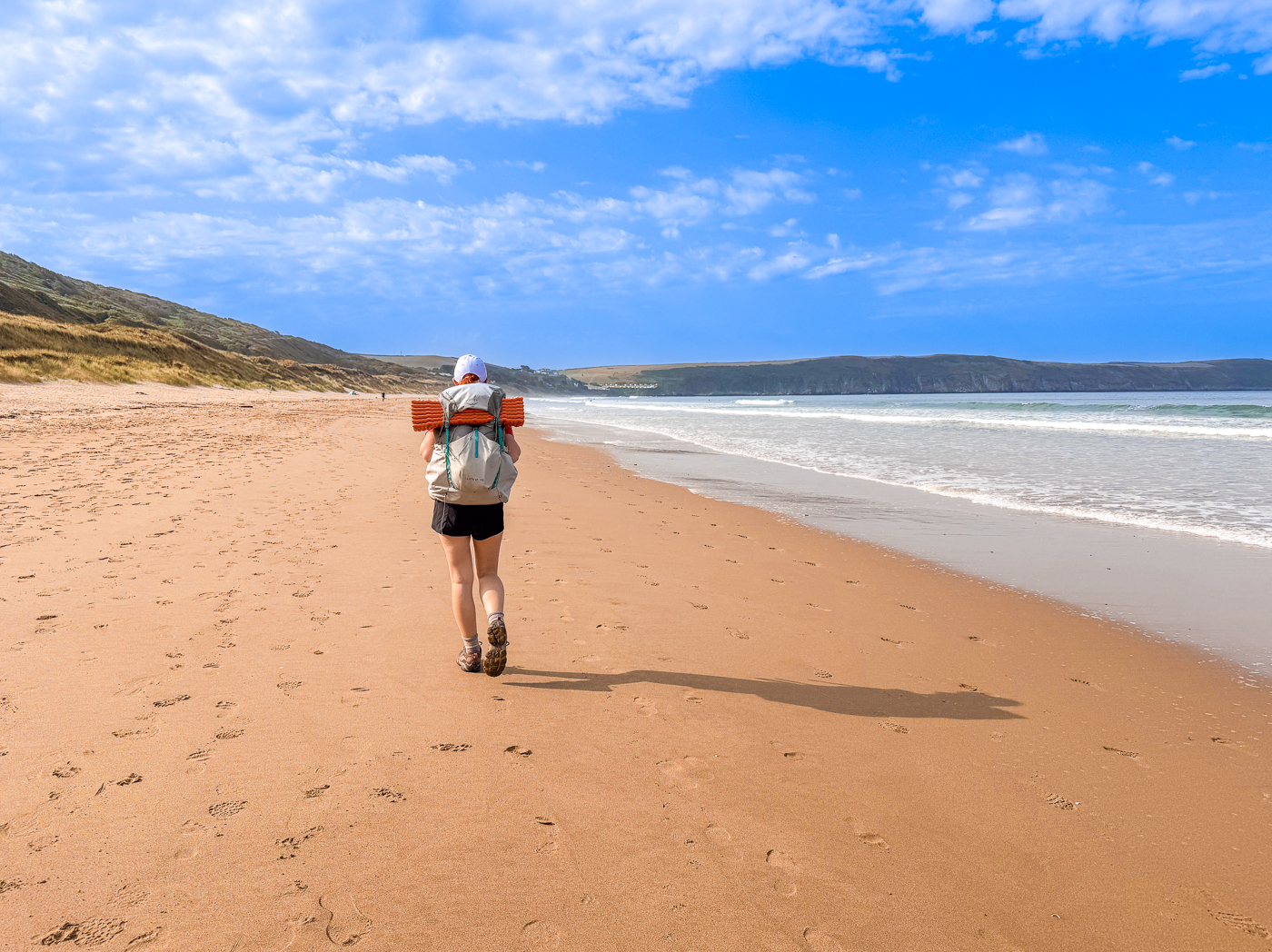
And that’s everything I took on the South West Coast Path!
From the essentials for my body — like medications, blister care, and electrolytes — to the tech that kept me connected, and all the miscellaneous items that made life on the trail manageable, every item had a purpose. Some things I used every day, others I carried in case of emergencies, but knowing I had them gave me peace of mind and let me focus on enjoying the walk.
Packing for a long-distance hike is always about balance: bringing enough to cover your needs without overstuffing your backpack, and anticipating challenges without overthinking. I hope this list helps you do just that! With careful planning and thoughtful choices, you’ll be free to enjoy every cream tea, challenging scramble, and pristine beach the path has to offer.
Happy walking!
The post How to Pack for the South West Coast Path appeared first on Never Ending Footsteps.
feeds.feedblitz.com (Article Sourced Website)
#Pack #South #West #Coast #Path
